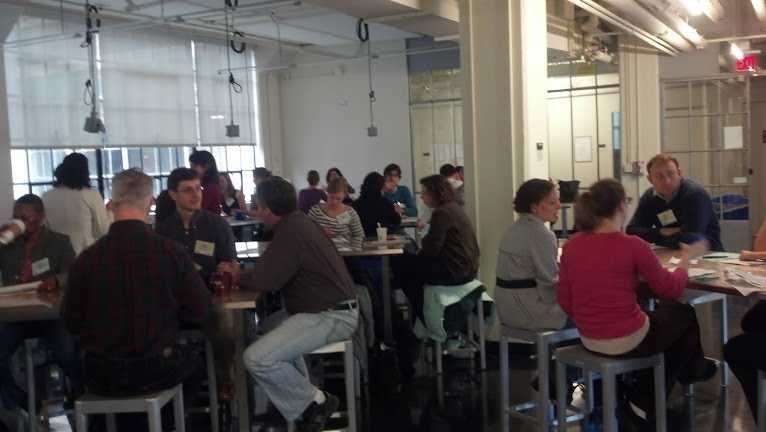“What do you want to be when you grow up?” is a big question for children, and knowing of only a few options can limit their future aspirations. The Telling Your Story (TYS) Workshop seeks to change that, offering children the opportunity to hear the life stories of scientists and engineers in their very own classroom. At the very least, it helps them know that scientists and engineers are interesting people with whom they might like to be friends. And some might just get that inspirational spark to pursue a science, technology, engineering or mathematics (STEM) career.
At the recent TYS workshop, held in November, 17 fourth through eighth grade teachers met with 20 scientists and engineers for a day of presentations and one-on-one and small group discussions. The scientists and engineers were graduate students from MIT and Harvard University, as well as alumni working in the public and private sector. Scientists and engineers had a chance to practice "telling their story" to teachers, and to make plans for future classroom visits. Teachers shared their curriculum, teaching standards, and their expectations for a visitor.
Jessica Garrett, of the MIT Edgerton Center, has organized the past three workshops with Phoebe Cohen of the MIT NASA Astrobiology Team and Peg Legendre and Sung Kim of the Cambridge Science Festival. “Participants have told us that the most valuable piece is the networking time so we try to build in as much time for that as we can," Garrett says. "We developed ‘speed-chats’ (based on speed dating) where a scientist or engineer chats one-on-one with a teacher for 10 minutes. Then they get to meet someone new. By the end of the workshop, people have had a chance to chat with at least seven other people. Once we get everyone talking to each other the excitement in the room is palpable. When it is time to move on to the next segment, people just want to keep sharing ideas.”
Sarah Rosengard, a graduate student in chemical oceanography at Woods Hole, and Leilani Roser, a biology teacher from Charlestown High School, shared their tips on how to plan ahead so that the visit satisfies everyone’s expectations. The pair showed highlights from Rosengard’s story and explained how their partnership developed into a rich project including a water sampling field trip to the Charlestown navy yard.
“We want classroom visitors to share their career story through photos and artifacts for students to see and touch, and activities for kids to try," Garrett says. "We try to model this in the way we structure our workshop, so there is plenty of show-and-tell, time to discuss and a hands-on activity for participants to experience. This time participants modeled the evolution of bird beaks by using forks, spoons or chopsticks to pick up cotton ball or rubber band ‘food.’ Participants could see how the populations of different bird beaks shifted over time in response to the available food source.”
Caroline Zeiner, a graduate student at Harvard in environmental microbiology, who visited several classrooms to tell her story in 2011, shared her approach with this year’s participants. Zeiner begins her presentation by showing the children pictures of Lady Gaga and Justin Bieber and telling them how science and engineering figure into their performances, whether it is a meat dress worn by Lady Gaga or the acoustic engineering the singers use. As a hands-on activity, students touch their unwashed hands to petri dishes and watch as their own microorganisms grow over the next week.
Kyle Delwiche, a graduate student in environmental engineering at MIT, who attended the workshop, believes that scientists have an obligation to society. “It’s not this foreign scary thing, and it is accessible even if you don’t end up doing it. You can still understand and appreciate it and understand that it touches all aspects of our lives.” Delwiche says.
Rich Monagle, a McCall Middle School teacher in Winchester, Mass., and past and current TYS participant, met an engineer at the 2011 TYS workshop. The engineer, who visited the classroom to "tell her story," went on to help create a robotics course for the seventth grade. That same engineer is now teaching the first period of each day while continuing to be a full-time engineer. “It’s a great relationship to have,” Monagle says. “I think this is amazing.”
The TYS program was sponsored and organized by the MIT Edgerton Center and the Cambridge Science Festival and was held in the International Design Center at MIT’s Building N52. TYS was originally developed by Technical Education Research Centers for the Center for Ocean Sciences Education Excellence New England.
Garrett hopes to run another TYS workshop in April. Sign up
Telling Your Story workshop connects scientist and engineers with teachers and in the process helps to demystify STEM and excite the next generation of learners.
Publication Date:

Caption:
The buzz in the room was infectious at the 'Telling Your Story Workshop' held at the International Design Center in Building N52.
Credits:
Photo: Anique Olivier-Mason





